HP Z420 Workstation Review: Competition Heats Up
by Dustin Sklavos on May 21, 2012 12:00 AM ESTApplication and Futuremark Performance
It stands to reason PCMark is going to have a field day with the fast SSD used for the system drive and the eight-core, sixteen-thread Intel Xeon that's powering our HP Z420 review unit. What should be particularly interesting, however, will be our CPU-isolated benchmarks.
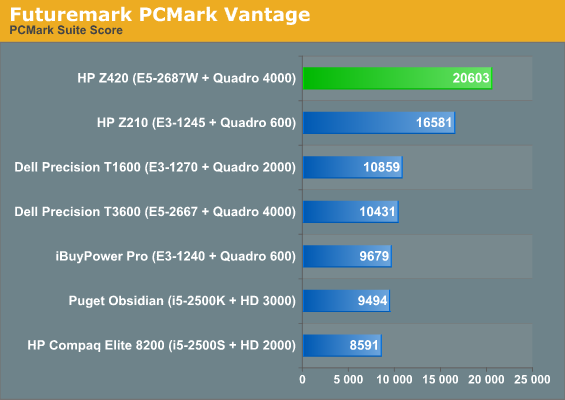

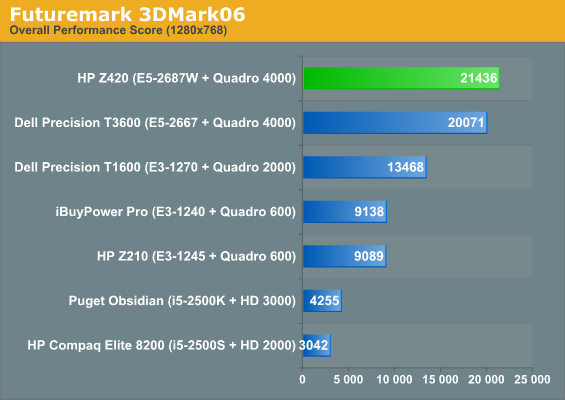
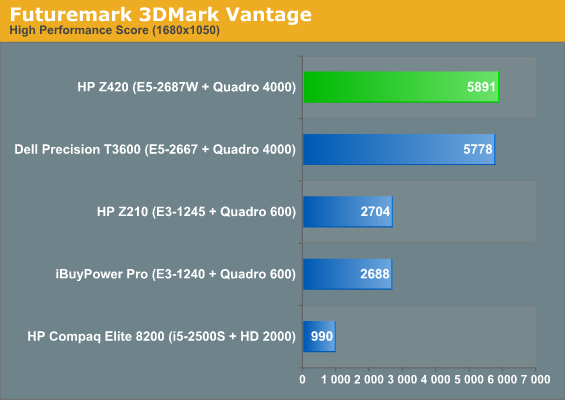
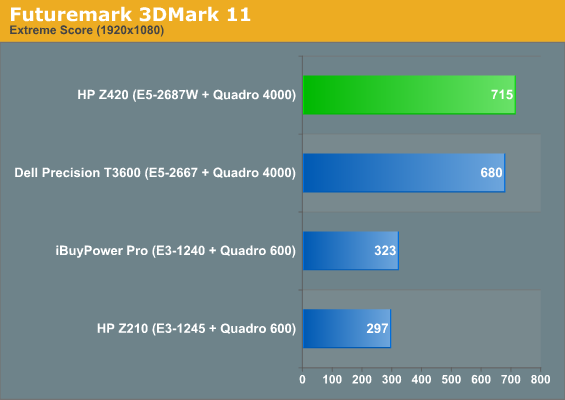
The Z420 runs away with PCMark while even the 3DMarks see a slight boost from the extra CPU performance on tap. It's just enough to put the Z420 ahead of the T3600 in every chart. For comparison's sake, it's worth noting that boutique gaming desktops with consumer-class SSDs (tuned more for performance than reliability) pretty much start at where the Z420 lines up in PCMark, while even a 768MB GeForce GTX 460 offers a better gaming experience than the Quadro 4000. Bottom line: this is not a gaming system.
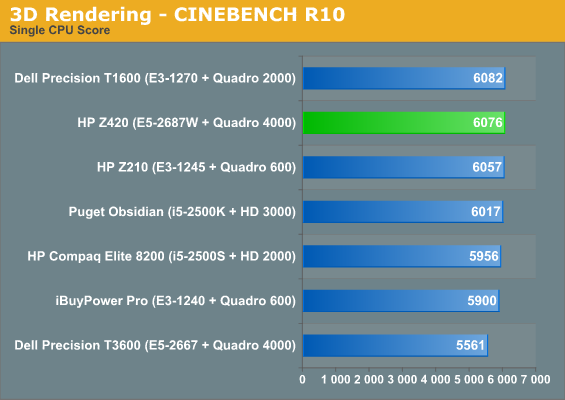
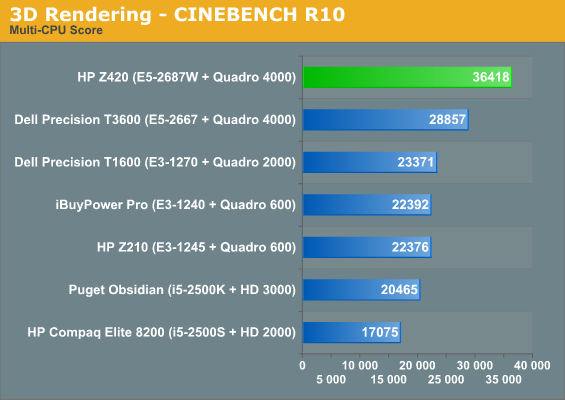
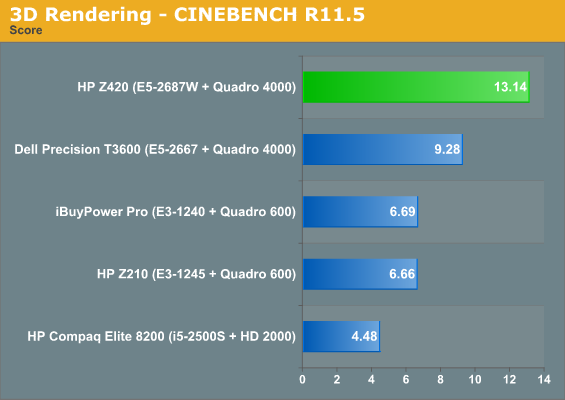
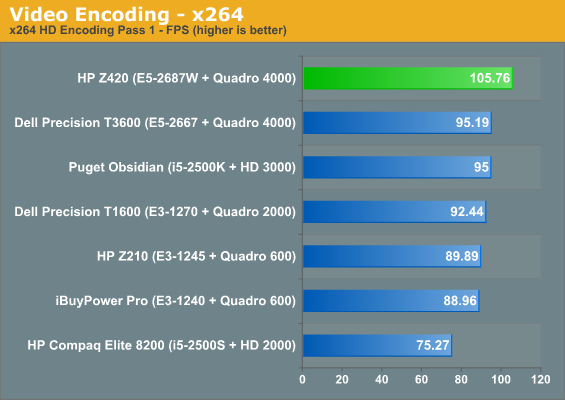

In single-threaded tasks the E5-2687W is certainly respectable, but the instant the extra cores can be leveraged it tears past the other test systems. It takes a 4.6GHz i7-3960X to even match or beat the Z420's E5-2687W (as tested here), but the fact that a hexa-core chip can beat an octal-core chip in these tasks is telling. The E5-2687W is probably going to be the fastest workstation chip you can find and the Z420 demonstrates that, but enthusiasts who've periodically looked at enterprise-class hardware are going to want to steer clear, as even modern video encoding tasks may not be adequately threaded to keep the E5-2687W working at full tilt.










35 Comments
View All Comments
satai - Monday, May 21, 2012 - link
How do Dell and HP offerings compare related to noise? Does anybody offer an ULN workstation with enough horsepower?Dustin Sklavos - Monday, May 21, 2012 - link
I can't give you definitive noise figures, but I can tell you the Precision was noticeably quieter than the HP. The T3600 was very quiet, while the Z420 was noticeable. Not LOUD, but definitely audible.satai - Monday, May 21, 2012 - link
Thanks. That helps me a much.ectoplasmosis - Monday, May 21, 2012 - link
Why on earth would you not test noise as part of the review? Not what I'd expect form Anandtech.thewhat - Monday, May 21, 2012 - link
The case, layout and cooling seem very generic. At this price point I'd expect something better.It seems that quiet builds are never a priority with big companies like HP and Dell.
piroroadkill - Monday, May 21, 2012 - link
In my experience Dells have always been pretty good in this area, they were the first to adopt BTX style cases with CPUs at the front with nice intakes (if not the first, they must be close!) and always have nice extensive cowling, temperature adaptive fans, and generally are nice to service.Taft12 - Monday, May 21, 2012 - link
Fully agree with you there - I've found Dell desktops to always be whisper quiet compared to any PC assembled from parts unless special care has been taken to choose parts geared for silencemapesdhs - Tuesday, May 22, 2012 - link
Very true, I have a Dell T7500 (dual XEON X5570), it's extremely quiet. It makes so little
noise, sometimes I forget it's turned on.
Ian.
behold4r - Monday, May 21, 2012 - link
I would like to ask something very specific. I know that many of you might find this a joke, but still I would like to know, because I haven't had the opportunity to own such a machine myself but I am in the process of researching such an option.I would like to ask if you could overclock the Xeons (the E5-2687W for example on this system) in order to take them up to 4.0GHz , just like an intel 3960 cpu can. Is there such an option in the BIOS (whether it is on the HP machine or with some other motherboard you've seen)
That would it make very attractive for rendering or fluid simulation (more bang for your buck, and since we are talking about ~1.900$ these are a lot of money for a single cpu)
And one other thing, would it be possible in your tests of server cpus (xeons or opterons) to include any fluid simulation test, in particular with RealFlow as well as any rendering tests with a real scene (meaning not just cinebench but rendering a maya scene in mental ray, and I am not talking about prefabed tests like specviewperf)
fic2 - Monday, May 21, 2012 - link
I don't know about this system, but in general large PC companies such as HP and Dell do not leave any overclocking options in their bios.For that you are generally better off either building your own, going with a small PC builder or going with one of the companies that specializes in high end overclocked systems.